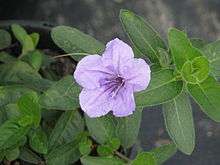Ruellia humilis
| Ruellia humilis | |
|---|---|
 | |
| Scientific classification | |
| Kingdom: | Plantae |
| (unranked): | Angiosperms |
| (unranked): | Eudicots |
| (unranked): | Asterids |
| Order: | Lamiales |
| Family: | Acanthaceae |
| Genus: | Ruellia |
| Species: | R. humilis |
| Binomial name | |
| Ruellia humilis Pohl ex Nees | |
| Synonyms | |
|
Ruellia ciliosa var. longiflora | |
| Wikimedia Commons has media related to Ruellia humilis. |
Ruellia humilis (wild petunia,[1] fringeleaf wild petunia,[2] hairy petunia, low wild petunia) is a species of flowering plant in the Acanthaceae, the acanthus family. It is native to the eastern United States.[1] It is grown as an ornamental plant.[3]
Ruellia humilis is native to the U.S. from the northeastern/northern central to the southeastern/southern central regions. According to the Germplasm Resources Information Network of the United States Department of Agriculture, Ruellia humilis is native to the following states:[1]
Alabama, Arkansas, Georgia, Illinois, Indiana, Iowa, (eastern) Kansas, Kentucky, Louisiana, Maryland, Michigan, (southeastern) Minnesota, Mississippi, Missouri, Nebraska, (western) North Carolina, Ohio, Oklahoma, Pennsylvania, Tennessee, (eastern) Texas, West Virginia, Wisconsin, and Virginia.[1]
It is not well-known or used much in conventional nurseries or gardens, but use in gardens has been increasing as native plants become more popular. It is usually about one foot high, but can get to two feet high. Its opposite leaves are to 2.5 inches long by 1 inch wide and are light green to medium green with smooth margins and are covered with soft white hairs on both sides. The funnel-shaped 5-lobed flowers are about 1.5 to 2.5 inches in diameter and do resemble petunias, as does the rest of the plant. The lavender flowers bloom in July into September and open in the morning and fall off in the evening.
References
- 1 2 3 4 Ruellia humilis. Germplasm Resources Information Network (GRIN).
- ↑ "Ruellia humilis". Natural Resources Conservation Service PLANTS Database. USDA. Retrieved 25 October 2015.
- ↑ Ruellia humilis. Missouri Botanical Garden.
Further reading
- Blanchan, N. (2002). Wild Flowers: An Aid to Knowledge of our Wild Flowers and their Insect Visitors. Project Gutenberg Literary Archive Foundation.
